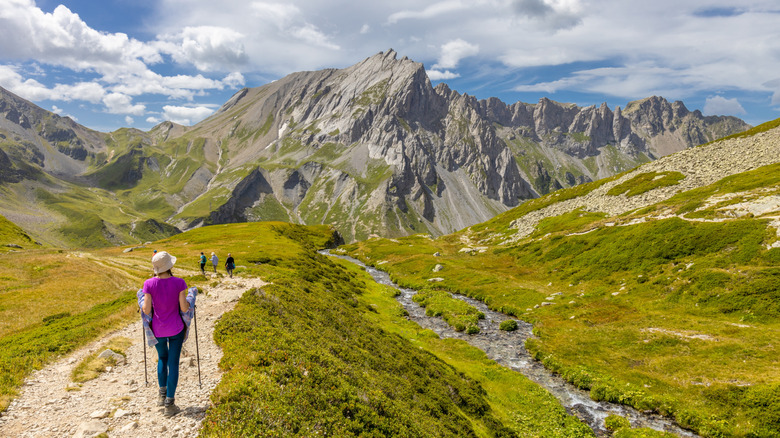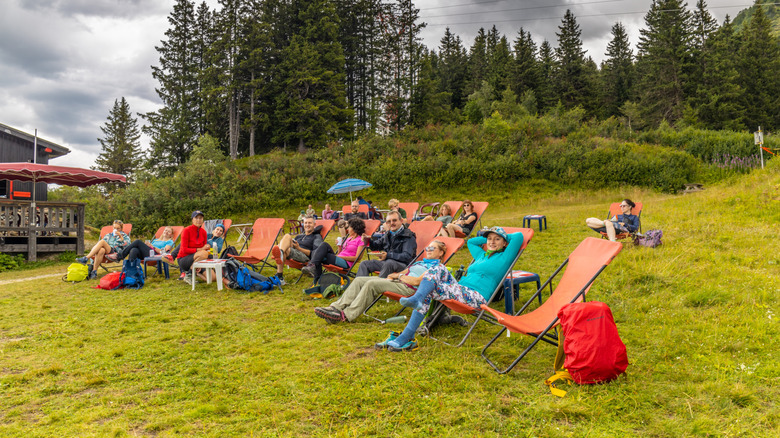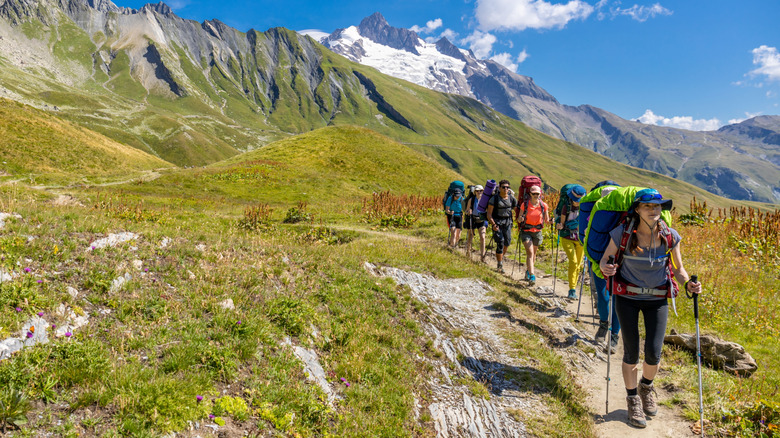One Epic Alpine Trail In Europe Completely Changed Rick Steves' Perspective On Hiking
Straddling the borders of France and Italy, Mont Blanc stand at 15,771 feet and is the tallest peak in western Europe. Part of the Alps, Mont Blanc is viewed by many to be the pinnacle (pun intended) of European hiking. However, not all travelers to this part of Europe are keen on lacing up their hiking boots and taking on this behemoth. Indeed, a good many travelers, including author and television host Rick Steves, are not overly keen on the idea of multi-day treks through the snowcapped Alps. However, one trail, the Tour du Mont Blanc, opened Steves' eyes to the beauty of hiking in Europe.
Described by Steves himself as the "best hike of my life" the Tour du Mont Blanc (TMB) is a popular, and accessible alpine walk for hikers of various skill levels. While the 112-mile loop that circumnavigates Mont Blanc across three international borders may seem daunting, the reality of this trek is much different. In fact, the TMB was so enjoyable that it completely changed Steves's mind about hiking.
"Here I am, supposed to be this expert on European travel, and I've never done a multi-day hike in the Alps," Steves said in an interview with Outside. "It was something totally new to me, and now I want to tell everybody what a great travel option it is." Steves, who was 66 when he hiked the TMB in 2021, believes this trail can get anyone hooked on hiking like it did him.
Why Rick Steves loves the Tour du Mont Blanc
Despite the trail's overall length and average daily ascent of 3,000 feet, the TMB offers tremendous European scenery and culture without requiring hikers to make too many sacrifices. One of Steves' favorite features is the "sherpa service" that will transport your bags to the numerous mountain huts that dot the trail. "That frees me up to hike with just the essentials in a small day bag," he said in an episode of Rick Steves' Europe about the TMB.
The trail huts are another provision Steves adores. Conveniently placed a day's hike away from one another, the huts offer literal "refuges" — what they are called locally — for hikers. They have beds, food, wine, cold beer, and the chance to meet a community of fellow hikers. Some refuges offer the option to book a private room, but you always need to bring your own sleeping gear. Alternatively, if you want more creature comforts, there are some hotels along the trail as well.
Another highlight is the village of Chamonix, which is home to some of the most exciting natural attractions in France. As the start and end point of the TMB, Chamonix is where you can find all the information you'll need to hike the trail. Steves recommends stopping by the Mountain Guide Center to get as much information as you can before you leave on your trek. If you don't want to hike but still want to soak up the scenery, Chamonix offers a panoramic cable car up Mont Blanc that offers truly stellar views.
Planning your Tour du Mont Blanc hike
While the TMB is not generally considered beginner-friendly, take a leaf out of Steves' book and break up the journey into sections. He and his friends hiked 60-miles of the trail, and took local buses through the parts they either did not want to hike, or where the terrain would have been too tricky. Talk to one of the knowledgable team members at the Mountain Guide Center to determine what sections are best for your ability.
Experienced through-hikers will find the Tour du Mont Blanc to be a lot easier than some famous multi-day American routes like the Appalachian Trail or Pacific Crest Trail. At a steady, recommended clip of 10-miles a day, you can finish the Tour du Mont Blanc in 10 days. That's an excellent time frame to have an adventure that takes you through three countries.
To prepare, Steves recommends booking hut or hotel beds well in advance of your trip, because they can fill up fast. He also stocks up on good hiking essentials, like socks, poles, a backpack, moleskin for blisters, metal water bottle, and good shoes. He also thinks it'd be a good idea to hike at home before you head to the TMB. "I'd recommend choosing a practice hike with a 3,000-foot elevation gain so you can use it as a reference point," Steves explained.


